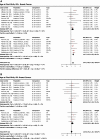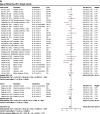Modern reproductive patterns associated with estrogen receptor positive but not negative breast cancer susceptibility
- PMID: 25389105
- PMCID: PMC4362290
- DOI: 10.1093/emph/eou028
Modern reproductive patterns associated with estrogen receptor positive but not negative breast cancer susceptibility
Abstract
It has long been accepted that modern reproductive patterns are likely contributors to breast cancer susceptibility because of their influence on hormones such as estrogen and the importance of these hormones in breast cancer. We conducted a meta-analysis to assess whether this 'evolutionary mismatch hypothesis' can explain susceptibility to both estrogen receptor positive (ER-positive) and estrogen receptor negative (ER-negative) cancer. Our meta-analysis includes a total of 33 studies and examines parity, age of first birth and age of menarche broken down by estrogen receptor status. We found that modern reproductive patterns are more closely linked to ER-positive than ER-negative breast cancer. Thus, the evolutionary mismatch hypothesis for breast cancer can account for ER-positive breast cancer susceptibility but not ER-negative breast cancer.
Keywords: age of first birth; breast cancer heterogeneity; cancer evolution; evolutionary mismatch; hormone-associated breast cancer; parity.
© The Author(s) 2014. Published by Oxford University Press on behalf of the Foundation for Evolution, Medicine, and Public Health.
Figures





References
-
- Kelsey JL, Bernstein L. Epidemiology and prevention of breast cancer. Annu Rev Public Health. 1996;17:47–67. - PubMed
-
- Althuis MD, Fergenbaum JH, Garcia-Closas M, et al. Etiology of hormone receptor-defined breast cancer: a systematic review of the literature. Cancer Epidemiol Biomarkers Prev. 2004;13:1558–68. - PubMed
-
- Bauer KR, Brown M, Cress RD, et al. Descriptive analysis of estrogen receptor (ER)-negative, progesterone receptor (PR)-negative, and HER2-negative invasive breast cancer, the so-called triple-negative phenotype: a population-based study from the California cancer Registry. Cancer. 2007;109:1721–28. - PubMed
-
- Colditz GA, Rosner BA, Chen WY, et al. Risk factors for breast cancer according to estrogen and progesterone receptor status. J Natl Cancer Inst. 2004;96:218–28. - PubMed
LinkOut - more resources
Full Text Sources
Other Literature Sources

